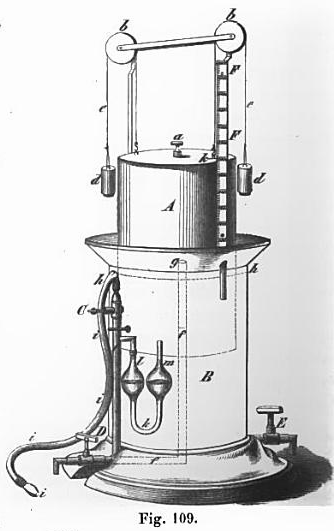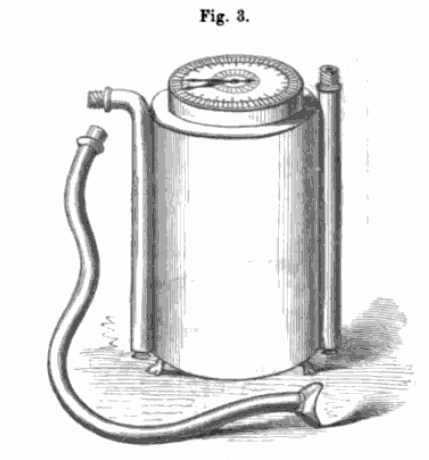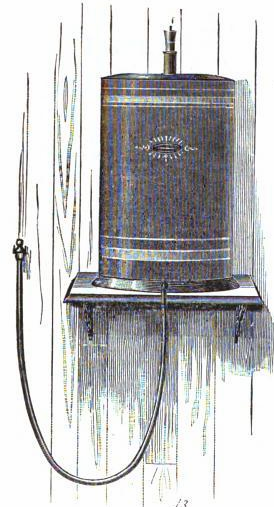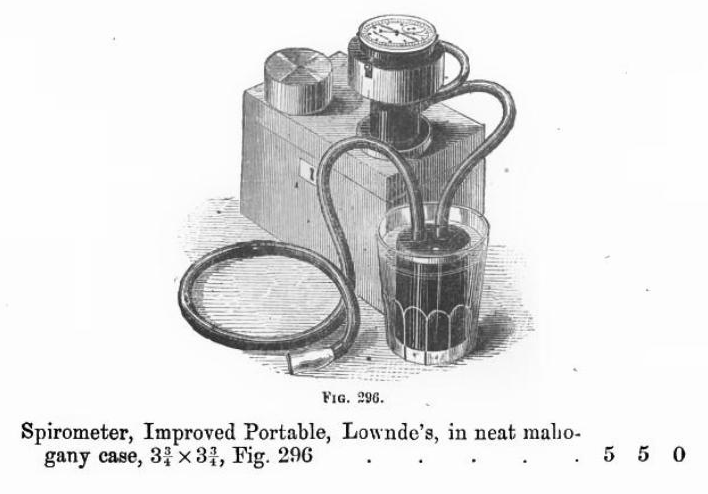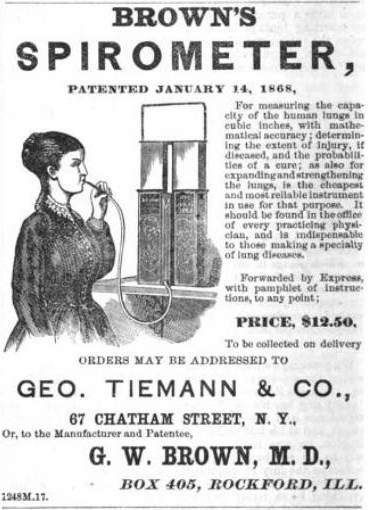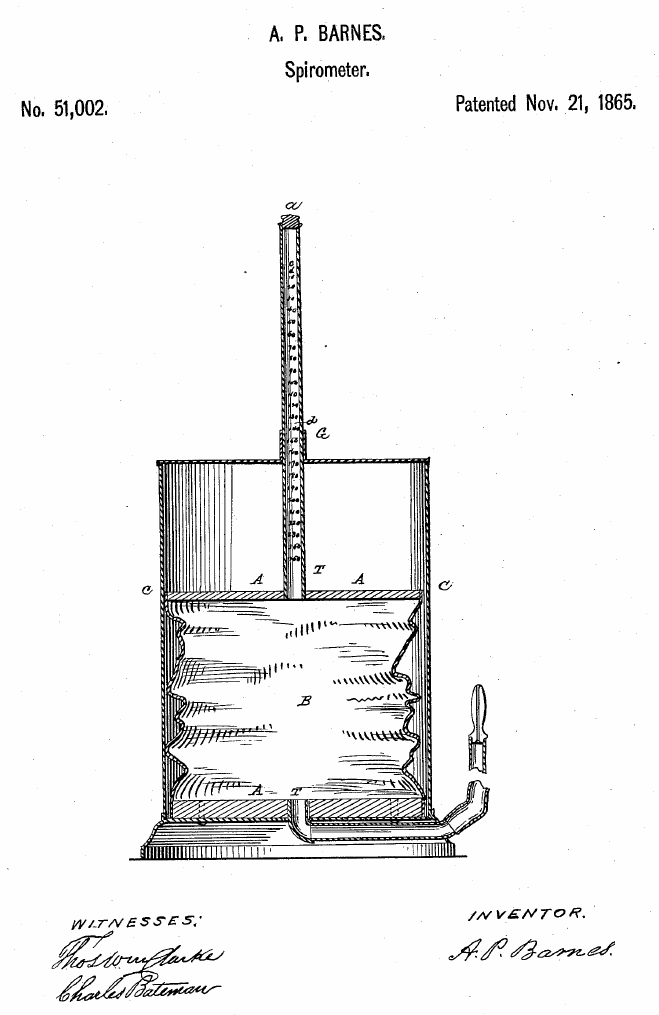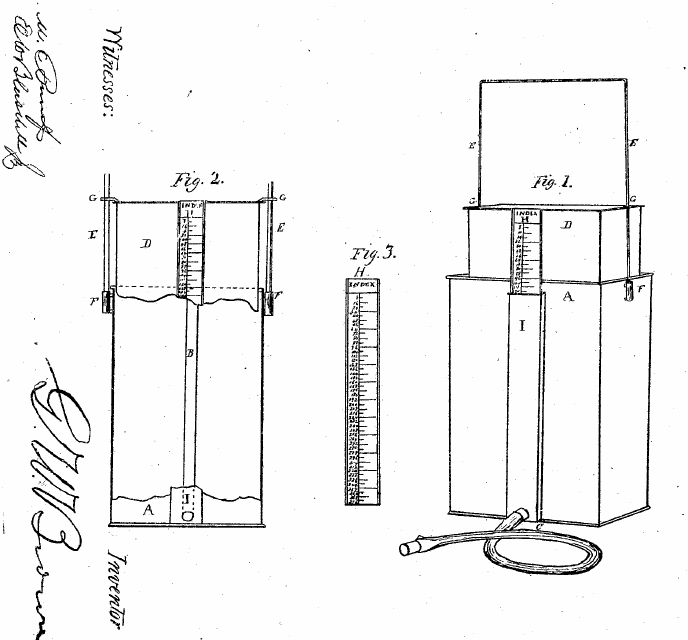|
From: Essay on medical pneumatology by By Jean Nicolas Demarquay and Samuel S. Wallian, 1889, page 265. From a chapter on “Aerotherapy” or treatment with oxygen. The oxygen was created chemically and then stored for use. “Metal gasometers with a capacity from fifty to 100 gallons are generally adopted for office use when other than small quantities of gas are needed. Zinc and galvanized iron are both used, the latter preferable because stronger and more durable. The best forms have self-supporting frames and weights adapted to balance the weight of the bell, or gas holder, as it rises and falls.” |
Spirometer, Hutchinson, 1859
Spirometer, Dr. Mitchell’s, 1863
From: A Treatise on hygiene. By William Alexander Hammond, 1863, page 42.
“A spirometer, made upon the plan of a dry gas meter, has been for some time employed in Germany, and was introduced into use by Dr. W. Weir Mitchell. It is altogether more simple in its management than the rather clumsy instrument of Hutchinson, and affords fully as accurate results.”
Spirometer, Dry, 1887
Spirometer, Modified Hutchinson, 1888
Spirometer, Lowndes, 1876
Spirometer, G.W. Brown’s, 1870, Advertisement
Spirometer, Barnes, 1865
Spirometer, G.W. Brown’s, 1868
Drawings from his patent (#73229) for the spirometer dated 1868. From this It is apparent that it is a rectangular water-seal spirometer. It was made of tin plate and its dimensions are listed as 8-1/2 inches wide, 4-1/2 inches deep and 13-1/2 inches tall. The wire “handle” that projects over the top was a guide for the inner spirometer reservoir (bell). The index (ruler) was attached to the inner reservoir and had a cover that protected it from wear. A 1/4″ of vertical movement was equivalent to 8 cubic inches. He specifically claimed that the guide rods and shield for the index were unique to his invention.
Spirometer, Hutchinson, 1894
From: A Text-book of Pathology: Systematic & Practical, Volume 2, Part 1, by David James Hamilton, 1894, page 50.
“Means of measuring the Vital Capacity – Hutchinson Spirometer.
“This instrument consists of a vessel containing water, out of which a receiver is raised by breathing into a tube; the height to which the receiver is raised indicates the volume of the vital capacity.
“To prepare the instrument for use.
“(1) Place the instrument about three feet from the ground on a firm, level table.
“(2) Turn off the water tap (fig. 235, 4) and open the drain tap (5) seen at the bottom of the spirometer.
“(3) Pour water into the spout at the back until it rises behind the slip of glass (3) placed above the air tube.
“(4) Slide the movable index (2) opposite zero on the scale and add water until it is exactly level with the straight edge of this index. Should too much water already be poured into the spirometer, draw off by the tap (4) sufficient to bring the water down to the edge of the index.
“(5) Pour a little colored spirit into the bent tube (6) until it rises in the two legs of this tube about 3-1/2 inches (7).
“(6) Fix the rods (8) into the sockets (9) on each side at the top of the spirometer.
“(7) Place the cross-head (10) upon these rods, so that the name of the instrument faces the operator; then pass the two red cords (11, 11) over the pulleys at each end of the cross-head.
“(8) Turn off the taps (5 and 1), then suspend the counterbalance weights (12, 12) to the red cord.
“(9) Screw the flexible tube (14) on to the extremity of the air-tube above the tap (1).
“(10) The small thermometer (13) may either be attached to the spirometer on the little hook above 13, or, which is better, hung up in any convenient corner of the room.
“The spirometer is now ready for making an observation”

